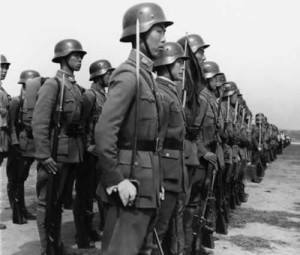The Battle of Shanghai in the Eyes of German Cameramen
- By Peter Harmsen
- 16 February, 2013
- 62 Comments
This German newsreel shows highlights of the 1937 battle of Shanghai. It’s interesting for a number of reasons. First, it features several of the weapons that were used most aggressively by the two sides of the struggle, including a Japanese 75 mm mountain gun (at 0:24), Chinese Curtiss Hawk biplanes (0:27), and a Japanese M25 Vickers Crossley four-wheeled armored car (0:55).
Even more interestingly, there is no obvious bias in the reporting of the events. The commentary restricts itself to merely describing what’s going on in the footage. At the same time, there is a surprising focus on the plight of Shanghai’s civilian population, and a large part of the two-minute newsreel shows streams of refugees weighed down by their belongings trying desperately to gain entry into the international part of the city, which was recognized by both the Chinese and the Japanese as a no-go zone.

Chinese infantry with German M35 helmets
It appears that the German media were free to report about the battle in Shanghai without being ordered to favor either side in a too obvious manner. This reflected the fact that Berlin’s diplomacy was in a state of flux. By 1937, there was growing understanding between Nazi Germany and the Japanese empire. They were united in their hostility towards the Soviet Union, reflected in the Anti-Comintern Pact, directed against Moscow, which the two had signed towards the end of the previous year. But they would not enter into a formal alliance – the Axis – until three years later.
In Shanghai in 1937, some German reporters put their freedom to report the events as they saw them – relative as this freedom was – to good use. Probably the best example was Lily Abegg, then 35 years old. She was actually Swiss, had spent part of her childhood in Japan, and reported from Shanghai for the German newspaper Frankfurter Zeitung.
As late as March 1940, when she published Chinas Erneuerung, a book about the conflict in the Far East, Abegg was able to write the following about the supreme Chinese leader Chiang Kai-shek: “No one believes that such a man has lived in vain – not even in Japan, where this great adversary has always been respected, in spite of all the hostility.”

 Copyright © 2025
Copyright © 2025
Leave a Reply